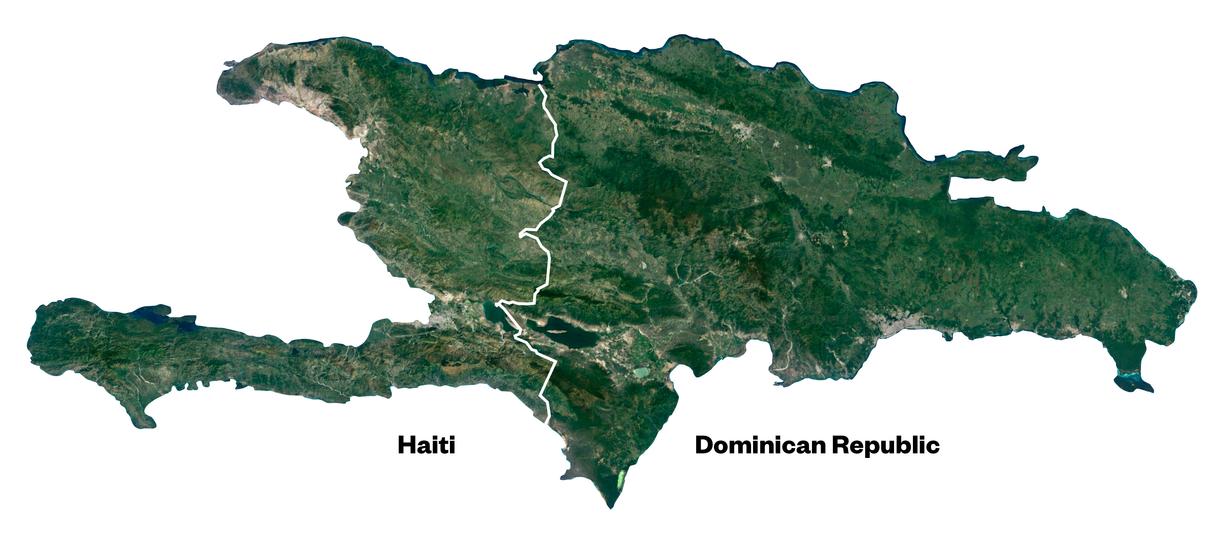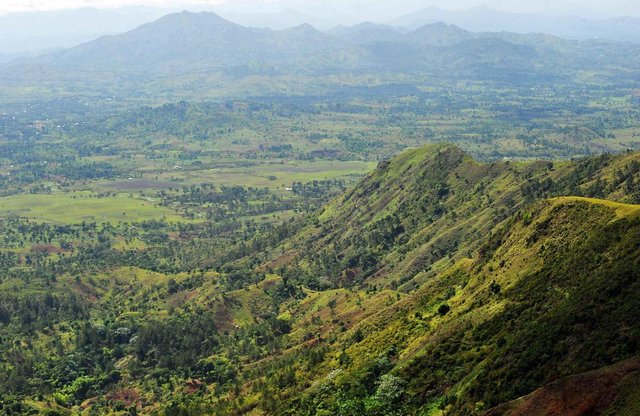When the geologist Peter Wampler first went to Haiti, in 2007, he didn't expect to see many trees. He had heard that the country had as little as 2 percent tree cover, a problem that exacerbated drought, flooding and erosion. As a specialist in groundwater issues, Wampler knew that deforestation also contributed to poor water quality; trees help to lock in rich topsoil and act as a purifying filter, especially important in a country where about half of rural people do not have access to clean drinking water.
Haiti is frequently cited by the media, foreign governments and NGOs as one of the worst cases of deforestation in the world. Journalists describe the Caribbean nation's landscape as "a moonscape," "ravaged," "naked," "stripped" and "a man-made ecological disaster." Deforestation has been relentlessly linked to Haiti's entrenched poverty and political instability. David Brooks, the conservative New York Times columnist, once cited Haiti's lack of trees as proof of a "complex web of progress-resistant cultural influences." More recently, a Weather Channel meteorologist reporting on the advance of Hurricane Matthew made the absurd claim that Haiti's deforestation was partly due to children eating the trees.
Few places in the world have as dismal a reputation. And as the recent destruction wrought by Hurricane Matthew shows, Haiti is tragically vulnerable to natural disasters. But as Wampler would discover, Haiti's reputation as a deforested wasteland is based on myth more than fact — an example of how conservation and environmental agendas, often assumed to be rooted in science, can become entangled with narratives about race and culture that the powerful tell about the third world.
Over the next five years, as Wampler crisscrossed the country for his research, he began to undergo a cognitive dissonance. "I heard that 2 percent number quoted everywhere," he said. "All the news outlets had this narrative that it's the poorest country in the Western Hemisphere and has 2 percent forest cover. But I'd been to these mountainous areas and seen forest cover that was more than 2 percent. I could see it with my own eyes."
He began searching for the original source of the forest-cover statistic. To his surprise, he couldn't find one. The few citations he discovered in scientific studies couldn't be substantiated. Some scientific and development literature used a 4 percent estimate that came from the Food and Agriculture Organization, a United Nations agency. That number also struck him as too low.
Wampler, a professor at Michigan's Grand Valley State University, uses geographic information systems and satellite imagery frequently in his work, and he decided to employ them to satisfy his curiosity about the trees in Haiti. He enlisted several students and began gathering high-resolution imagery of the island from LandSat, the database operated by the United States Geological Survey. Stitching together images from 2010 and 2011, he formed a mosaic that covered the entire country. He combined the images in three wavelengths to highlight vegetation and then trained a computer to spot trees in the images. To check the accuracy, he manually compared the computer's automated analysis to random samples chosen from Google Earth.
When the results came back, his first thought was that he had to do the whole process again. "Let's check this 10 times to make sure it's right," he told his colleagues. According to their analysis, Haiti's forest cover was more than 32 percent.
Wampler wondered whether they had set a sufficient minimum area for tree cover. So they used the FAO's definition of a "forest," which includes trees higher than 5 meters (about 16 feet) covering at least half a hectare. He ran the analysis again. The computer estimated Haiti's forest coverage at nearly 30 percent, a number similar to the coverage in the United States, France, and Germany, and far higher than in Ireland and England. Wampler had discovered a rarity in today's world: a good-news environmental story in one of the planet's poorest countries. But then he had a troubling thought: "People won't like this."
"It doesn't fit the narrative" that poverty causes deforestation and deforestation exacerbates poverty, he said. Foreign governments, charities, development banks, and the foreign media tend to present this relationship as an indisputable fact. "Organizations use this statistic as a lever to get funding and help. For them, it's a lot more convenient to have a narrative that works."
He had discovered a rarity in today's world: a good-news environmental story in one of the planet's poorest countries. But then he had a troubling thought: "People won't like this."[body_image src='//news-images.vice.com/images/2016/10/13/untitled-article-1476371601-body-image-1476372116.jpg' width='1024' height='689']
This now infamous aerial photograph of the border between Haiti and the Dominican Republic appeared in National Geographic in 1987. (James P. Blair/National Geographic/Getty Images)
For years, foreign journalists and academics rehashed Cobb's article. "Haiti on the Brink of Ecocide" was the title of one journal article published in 1994. A decade later, the Associated Press reported that "poverty has transformed Haiti's once-verdant hills into a moonscape" and "even the mango and avocado trees have started to vanish." Soon after, the best-selling author and academic Jared Diamond dedicated a chapter of his book "Collapse" to why Dominicans protected their forests while Haitians degraded theirs. The border photo appeared in Al Gore's 2006 documentary "An Inconvenient Truth."
Farmers and charcoal producers were blamed for the deforestation throughout the 20th century. But the destruction of the country's old-growth forest began far earlier with French colonists who cleared the land for slave plantations and used the wood in the sugar-production process. After colonialism, forest laws in many parts of the world as well as the emerging environmental movement borrowed the legal and ideological template of colonialism, explained Robbins, the University of Wisconsin-Madison ecologist, and criminalized poor people's use of trees.
But evidence that poverty causes deforestation is pretty scarce. "Deforestation and poverty correlate at the regional and national level," Robbins explained in an email, "but of course, correlation is not causation! Poor places experience forest-cover loss because they are exploited by wealthy places."
When the French lost their prize colony in 1804, they levied an indemnity on the new Haitian government as punishment. To pay this debt, Haitians began exporting mahogany to France; by 1842 they were sending 4 million cubic feet of it overseas every year. "Much of the deforestation of the precious hardwoods occurred in the 19th century when the Haitian government turned over mahogany forests to outside companies," said Gerald Murray, an anthropologist and professor emeritus at the University of Florida. "Then it was the outside world — USAID, the World Bank, the United Nations — that later decided deforestation was a problem in Haiti."
It was the outside world — USAID, the World Bank, the United Nations — that later decided deforestation was a problem in Haiti.
In 1979, USAID hired Murray, who had lived in rural Haiti for years, to find out why the agency's tree-planting programs weren't working. Despite 30 years of effort, Haitians didn't seem interested in planting forests. Murray spent a summer talking to farmers and peasants about trees. The tree-planting programs, he noticed, focused on ecology and, problematically, gave ownership of newly planted trees to the Haitian government, which the peasants distrusted. Murray thought the development agencies, under the influence of environmentalists, had gotten it all wrong. They saw trees as emblems of Mother Nature in need of saving. "It was too late! There were no original forests left," he said.
Murray's radical recommendation was that policymakers abandon "the podium and the pulpit" of ecology and saving nature and provide rural families with both seedlings and harvest rights to the trees they grew. He predicted that under those conditions, Haitians would fill the landscape with trees. Over the next two decades, a project funded by USAID and implemented by the Pan American Development Foundation resulted in more than 300,000 Haitian peasant households planting 65 million trees.
Murray continues to visit Haiti each year and was not at all surprised by the results of Peter Wampler's study, though he said it is unlikely that his project — which planted trees specifically for harvest — is responsible. It's possible that a third of Haiti had tree cover all along.
It's more likely that Haiti's practice of carefully managed woodlots known as rakbwa, in which trees are grown, culled and sold for construction or charcoal, have played a role in sustaining the country's tree cover. Tarter, the anthropologist in Haiti, told me that rakbwas have been in use for nearly two centuries, and his guess is that Wampler's finding represents a resurgence of trees. "I suspect that Haiti might have actually been more denuded 30 years ago," he said. "Trees with deeper taproots are growing up on land that's been abandoned [as] people are moving out of rural areas into urban areas."
If this turns out to be the case, the implications are amazing. Urbanization usually creates a greater demand for charcoal, because people in cities don't have easy access to firewood. So it's possible that over the last 40 years, Haitians not only avoided the environmental apocalypse predicted for them but also expanded their country's tree cover, even as the population has grown to 10 million people, more of whom live in cities.
Wampler is designing another study to compare present tree-cover levels with archival satellite images from the 1970s to determine whether his earlier results represent a decrease or increase in trees in the last four decades.
Whatever the extent of tree cover, soil erosion, groundwater contamination, and deadly flooding remain significant problems in Haiti. Cultivating treeless, steep mountainsides for agriculture, a common practice, is environmentally damaging and allows topsoil to wash out. Haiti's tree cover may be around 30 percent, but it is patchy, which affects biodiversity, drought, water quality and the impact of natural disasters like Hurricane Matthew, now estimated to have taken at least a thousand lives. These types of events are only expected to increase with climate change.
"In terms of ecological theory, a small patch of forest is not equal to a forest," explained Starry Sprenkle-Hypolite, an ecologist in Haiti. People are not ignorant of these issues; they just don't have the resources to fix them, she explained. "There is a lot of consciousness of the environment and nature and environmental ethics here; it's a lack of means that is the problem."
At least one development organization is changing its approach based on the new forest-cover data and a greater understanding of local management practices. J/P Haitian Relief Organization, founded by the actor Sean Penn, is currently raising $300 million in partnership with the Haitian and French governments to enhance Haiti's climate resiliency. The project, called "Haiti Takes Root," has launched a study with the World Bank to better understand charcoal production and consumption. "Because it's illegal and informal and misunderstood, charcoal has been the bogeyman," said Chris Ward, the project's executive director. "But it's the biggest agricultural value chain in the country. We might be able to use that as a driver of reforestation, not deforestation."
Reforestation may prove simpler than correcting the decades of environmental doomsaying that has contributed to Haiti's status as the world's favorite disaster story. But statistics tell much more than a story of wretchedness in Haiti; they also reveal ingenuity.
M.R. O'Connor is a journalist and the author of "Resurrection Science: Conservation, De-Extinction and the Precarious Future of Wild Things."

Hi! I am a robot. I just upvoted you! I found similar content that readers might be interested in:
https://news.vice.com/story/one-of-the-most-repeated-facts-about-deforestation-in-haiti-is-a-lie
Downvoting a post can decrease pending rewards and make it less visible. Common reasons:
Submit
Mohit vote
Downvoting a post can decrease pending rewards and make it less visible. Common reasons:
Submit
Have a nice day, good morning
Downvoting a post can decrease pending rewards and make it less visible. Common reasons:
Submit
आप सभी को स्वतंत्रता दिवस की ढेर सारी शुभकामनाये,

Downvoting a post can decrease pending rewards and make it less visible. Common reasons:
Submit